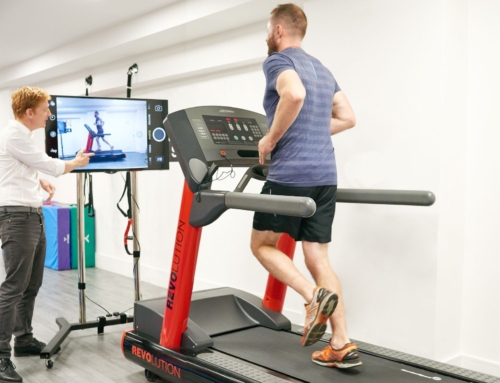
What is a lateral ankle sprain?
An ankle sprain is one of the most common lower limb injuries. It involves damage to at least one of the ligaments located around the outer side of the ankle (lateral side).
Lateral ankle sprains cause pain, swelling and limited mobility. Without treatment, recurrent sprains can occur, causing chronic instability problems within the ankle.
Sprains are graded based on their severity, ranging from a strain (mild), to a partial tear (moderate), to a complete tear (severe). When there is a complete tear, it can sometimes cause damage to the bone too – known as an avulsion fracture.
Anatomy
Your ankle is a hinge joint that allows motion up and down, and from side to side.

It is a complex joint, consisting of multiple muscles and ligaments that work together to provide stability, strength, flexibility and movement. Ligaments are strong, fibrous, band-like structures which attach bone to bone, and provide stability to the ankle joint. The ligaments of the ankle joint are categorised as either medial (inside) collateral ligaments or lateral (outside) collateral ligaments.
The lateral ankle ligaments are more susceptible to injury; specifically the anterior talofibular ligament (ATFL), calcaneofibular ligament CFL) and the posterior talofibular ligament (PTFL). The anterior talofibular ligament is reported to be the weakest of the three ligaments so is most often the ligament that is injured.
As well as giving the ankle stability the ligaments provide an even more vital role; over recent years researchers have found that the ankle ligaments contain tiny cells called proprioceptors, these cells provide sensory feedback to the brain, so that your brain knows where your ankle is in relation to your body and to the ground, and what position the ankle is in. Proprioception is closely tied to the control of movement and balance which is essential to help with injury prevention.
What causes a lateral ankle sprain?
A lateral ankle sprain can happen to anyone; it is an injury which is usually caused by a sudden twisting, turning, or rolling of the ankle to one side. The ankle joint is forced past its normal range of movement, which causes the ligaments in the lateral ankle to be stretched or torn.

Sprains are particularly common in sports that require quick changes of direction and jumping, however they can also be caused from slipping on an uneven pavement or stepping awkwardly off a curb. They can affect all age groups from young to old.
Risk Factors
- Previous ankle ligament injury.
- Weak in the muscles of the ankle and foot.
- Midfoot cavus (high arches).
- Hypermobility.
- Poor balance.
- Increased BMI.
- Participating in certain sports, such as football, rugby, basketball, netball, gymnastics.
- Wearing poorly fitting footwear.
What are the symptoms of a lateral ankle sprain?
A typical patient with piriformis syndrome complains of sharp, severe, pain in the buttock, with radiating symptoms down the back of the leg and into the thigh, calf, and foot. These symptoms often become worse after prolonged sitting, walking or running long distances, and may feel better when lying down on your back.
- Immediate pain.
- Swelling and/or bruising around the outside of the ankle.
- The feeling of weakness or instability of the foot and ankle.
- Tenderness to touch around the outside of the ankle.
- Difficulty standing or walking on the affected foot.
- Stiffness in the ankle joint, made worse with periods of rest and eased with gentle ankle movements
How is a lateral ankle injury diagnosed?

Our Physiotherapists at Complete are highly skilled in assessing and diagnosing ankle sprains. Your physiotherapist will listen to your injury history, and perform a thorough clinical examination to determine the severity of your sprained ankle. It is vital that you get a quick and accurate diagnosis, in order to ensure that you are started on the correct treatment pathway. If left untreated, your recovery will take considerably longer, and you may end up with recurring problems. In most cases, Complete Physio are able to offer urgent, next day appointments if needed.
Subjective Assessment
Initially your Physiotherapist will take you through a subjective assessment, asking you questions about how you injured your ankle and what your symptoms are. In almost all cases, there will be a history of having “rolled” the ankle over, e.g. a trip or fall off a step or landing awkwardly from a jump.
You will also be asked questions about your general health, your past medical history and what your normal daily activities and sports are.
Objective Assessment
After your consultation, your Physio will complete a series of clinical tests and a physical examination, to help develop a diagnosis. Depending on the severity of your symptoms this may include:
- Assessing swelling and bruising.
- Range of movement testing of your foot and ankle.
- Gently palpating (feeling) around the ankle joint.
- Measuring the strength, length and flexibility of your ankle and foot muscles.
- Testing the ligaments to see which are lax/torn – There are 2 specific tests; Anterior Draw for ATFL and Talar Tilt for CFL, which your physio will likely carry out.
- Looking at functional movements such as squatting, balancing, lunging, stepping.
- Gait (walking or running) analysis.
This process is often all that is required to make a diagnosis, however where symptoms are chronic or if the diagnosis is still unclear, your Physio may refer you for additional diagnostic tests such as an X-ray, Ultrasound imaging or MRI.
These tests will look more closely at the extent of the ligament and soft tissue damage, as well as confirm or exclude bone injuries or pathology.
X-RAY
X-rays are only able to show bony injuries and not soft tissue damage, therefore they have limited use when diagnosing an ankle ligament injury. However if a fracture is suspected, or to look at other bone pathologies then an x-ray will be required.
MRI
MRI imaging consists of a series of images which create a highly detailed, 3D image, allowing for visualisation of your injury, enabling an accurate diagnosis.
An MRI may be requested if your clinician believes you may have injured your ankle joint or the talus bone, or to rule out other pathologies in the foot and ankle.

MRI – Sprained Ankle.
Diagnostic Musculoskeletal Ultrasound Imaging
Research has shown that diagnostic musculoskeletal ultrasound imaging is an excellent and highly effective modality for assessing a lateral ankle sprain injury. It is capable of dynamically assessing the lateral ankle ligaments during movement, and visualising swelling and inflammation, as well as the extent of the ligamentous injury. The scan will diagnose if there is a partial or complete ligament tear.

At Complete Physio, we have a unique team of clinicians who are qualified as both physiotherapists and musculoskeletal sonographers. If you choose to book this service, your clinician will undertake a detailed clinical assessment, including a diagnostic ultrasound scan at your initial assessment.
If you would like more information about any of our physios or services, or would like to book an appointment with us then please contact us on 0207 4823875 or email info@complete-physio.co.uk.
How do we treat a lateral ligament sprain?
The vast majority of ankle lateral ligament injuries, including those which are classed as severe, can be treated by non-surgical means in the first instance.
Once you have a diagnosis, you will be given a clear explanation of your condition; we will ensure that you feel reassured, and help you set some rehab goals to allow you to feel engaged in your recovery process.
Physiotherapy
Your physiotherapy treatment will aim to:
- Reduce pain, swelling and inflammation.
- Regain full joint range of movement of the foot and ankle.
- Strengthen your foot, ankle and lower limb.
- Improve your proprioception, agility and balance..
- Improve your technique and function.
- Minimise your chance of re-injury.
In general, we suggest a three-phase process to get you back to full activity.
Phase 1
This includes rest from sport, compression, and regular icing to limit swelling. A short course of non-steroidal anti-inflammatory drugs, such as ibuprofen, can help (you should consult a GP or Pharmacist before taking any medication). Also, a small boot or ankle brace may provide extra support and comfort. If you are unable to weight-bear, then you may be issued with crutches for a few days.

Phase 2
Includes range of movement exercises, stretching, and a focused strengthening programme for the foot, ankle and lower limb. In addition, balance and proprioception exercises are essential to prevent a recurrence of injury.

During this phase, your physiotherapist may use manual therapy such as massage or soft tissue release techniques to the surrounding muscles, and joint mobilisations. This will help improve joint movement and reduce muscle stiffness or soreness.
Phase 3
Once your pain, strength, and range of movement improve, the next phase involves more complex, and sports/activity specific exercises. You will begin a gradual return to running, and work on multidirectional activities. Your therapist will also introduce agility drills to test the ankle.

At each treatment session your Physiotherapist will retest your objective markers, to monitor your progress, and will revisit your personal goals, so that we ensure you feel supported throughout your rehabilitation. We are dedicated to getting you back to full activity and function, and we have a highly skilled team of practitioners to ensure you succeed in returning to the activities you enjoy.
What if my pain and symptoms are not improving?
A small number of patients suffering from lateral ankle ligament sprains fail to improve with physiotherapy management alone. If physiotherapy treatment has not effectively reduced your pain and symptoms, and you have an accurate diagnosis of a lateral ligament injury from diagnostic imaging, then an ultrasound-guided injection may be the next appropriate step for you.
Ultrasound-guided Corticosteroid Injection
Cortisone injections can be very effective, particularly if you are getting pain at night, or you are not able to take part in normal daily activities, or engage in your physiotherapy, due to your pain and symptoms. Corticosteroid is a powerful, injectable anti-inflammatory medication that is routinely used to reduce pain and inflammation associated with musculoskeletal injury.
Significant research suggests that ultrasound-guided corticosteroid injections are an effective, evidence-based treatment option for persistent pain associated with lateral ankle injuries. At Complete, all injection techniques are performed under ultrasound guidance, as this ensures a more accurate treatment. Using ultrasound guidance has also shown to be less painful, and patients report fewer post injection complications.
Injections should never be a stand alone treatment; they provide a period of pain relief allowing for a ‘window of opportunity’ for you to rehabilitate your ankle effectively. Research has revealed a combination of corticosteroid injection and physiotherapy results in the most successful outcomes. At Complete we recommend that you restart a course of rehabilitation within two weeks after a corticosteroid injection.
This unique injection service is run by a team of highly skilled professionals who are fully qualified, independent prescribers, physiotherapists, musculoskeletal sonographers and injection therapists.
We are able to provide a one stop clinic, so that on your initial visit your clinician will provide an accurate diagnosis, prescribe the most appropriate medication for you, and complete an ultrasound-guided injection, all within the same session. We do not require a GP referral, you can simply self-refer directly into our same day service.
If you would like more information or would like to book an appointment please contact us on 0207 4823875 or email injections@complete-physio.co.uk.
Surgery for lateral ankle injury
Surgery is typically only recommended in cases when a rapid return to high level sports is required. Or when there is cartilage damage in the ankle joint. Surgery can also be helpful when people suffer from recurrent ankle sprains and lateral ankle instability, causing someone to keep going over on the ankle unexpectedly, during normal day to day activities.
Lateral ligament reconstruction is the first line procedure of choice, and has a very successful outcome in treating ankle instability. It is often performed together with an ankle arthroscopy to examine and treat any ankle cartilage damage. An internal brace can be used to protect the repair and allow early weight bearing in a boot, from approximately two weeks after surgery. Other procedures that involve tendon transfers are also possible but are reserved for revision surgery.
If you do require an onward referral for a surgical opinion, we will ensure that you are seen by one of the highly experienced, senior Orthopaedic Consultants who we work very closely with, and after surgery you’ll be referred back to your physiotherapist at Complete, to resume another course of post operative rehabilitation.
Don’t let pain hold you back, book now!





